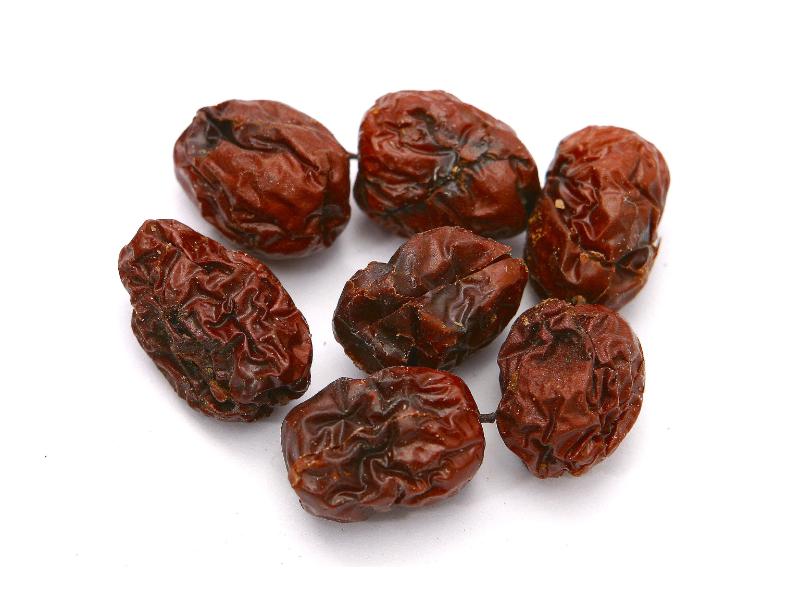Search in medicinals
Jujubae Fructus
Jujube
大枣 〔大棗〕 dà zǎo

Alternate English names: Chinese date red jujube
Alternate Chinese names: 干枣 gān zǎo; 美枣 měi zǎo; 良枣 liáng zǎo; 红枣 hóng zǎo; 枣 zǎo; 枣子 zǎo zǐ
Kingdom: Plant
Origin in PRC Pharmacopoeia: Ziziphus jujuba Mill. (PRC Pharmacopoeia)
Origin in unofficial sources: Ziziphus jujuba Mill.*; Ziziphus jujuba Mill. var. inermis (Bge.) Rehd. [= Z. vulgaris Lamarck var. inermis Bunge]
Use: Medicinal and alimentary
Category: Supplementing agents / Qì-supplementing agents
Properties: Sweet; warm.
Channel entry: Spleen and stomach channels.
Actions and indications:
- Supplements the center and boosts qì: Spleen vacuity.
- Nourishes blood and quiets the spirit: Blood vacuity with withered-yellow facial complexion; visceral agitation (zàng zào); disquieted spirit-mind.
- Harmonizes the nature of medicinals: Used in formulas to reduce the harsh nature and side effects of drastic medicinals while protecting right qì.
- Additional uses: Dà zǎo is combined with Shēng jiāng (生姜 Zingiberis Rhizoma Recens, fresh ginger) in exterior-resolving formulas to treat provisioning-defense disharmony. This combination is also used in supplementing formulas to regulate and supplement the spleen and stomach. In both instances, the effect of treatment is strengthened by using this combination.
- Modern applications: In recent years, it has been reported that dà zǎo has a positive effect on the treatment of allergic purpura.
Dosage and method: Oral: 3–12 pieces or 10–30g in decoctions. It may also be pounded to a pulp after removing the skin and seeds for use in making pills.
Warnings: Dà zǎo fosters dampness and heat, and easily causes center fullness. It is contraindicated in patients suffering from distension and fullness in the stomach duct and abdomen due to exuberant dampness, as well as in food or worm accumulations, tooth decay, or
Product description: This fruit is ovate or elliptical, 2–3 cm in length and 1–2 cm in diameter. The red ones (hóng zǎo), the type usually used in medicine, are rust red with large wrinkles. The black ones (hēi zǎo), which are usually only used in cooking, are blackish red with fine wrinkles. Both types have a luster. There are depressions at each end, usually with the remains of the style at one end, and the fruit stalk at the other. The exocarp is thick and leathery. The mesocarp is dark grayish brown, fat, sticky, and spongy. The endocarp is hard and spindle-shaped, and sharply pointed at one end. Within are two chambers each containing a flat, ovate seed.
Quality: Best are plump sweet red fruits with small stones.
Production area: Héběi, Hénán, Shāndōng, Sìchuān, Guìzhōu.
Back to search result Previous Next